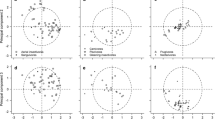Summary
-
1.
Five species of emballonurid bats (Rhynchonycteris naso, Saccopteryx leptura, Balantiopteryx plicata, Saccopteryx bilineata, and Peropteryx kappleri), were studied in Costa Rica and Trinidad. Stomach contents suggest that prey size generally increases for bat body size, but within these species there is considerable overlap. R. naso, S. leptura, and P. kappleri each appear to be specialized for foraging in a particular habitat type; B. plicata and S. bilineata are more opportunistic and feed over a variety of habitats during the year. While the other species feed in the proximity of surfaces, B. plicata is further separated from the other species by wing specializations favoring high altitude flight.
-
2.
Foraging dispersion is more closely related to body size than it is to social structure at the roost: small bats group-forage while larger bats feed in solitary beats. In all of the species, food is spatially and temporally variable, and the location of foraging sites changes seasonally in accordance with these locally varying patterns of aerial insect abundance. In the case of S. bilineata, the locations of foraging sites were positively correlated with levels of phenological activity in the underlying plant communities.
-
3.
Colony sizes ranged from small groups of 2–10 bats (S. leptura, P. kappleri), to intermediate colonies of 5–50 bats (R. naso, S. bilineata), to very large colonies with hundreds of bats (B. plicata).
-
4.
R. naso, S. leptura, and S. bilineata colonies have colony-specific annual foraging ranges which are actively defended against conspecifics from other colonies. In most cases, all members of a given colony of one of these species will be found foraging in a common site at any time. In R. naso and S. bilineata, currently used foraging sites are partitioned socially. In the former species, adult breeding females occupy a central area and groupforage while younger non-breeding females and males occupy peripheral foraging areas in the colony territory. In S. bilineata, the colony foraging site is partitioned into individual harem territories defended by harem males and containing the individual beats of all current harem females. For this latter species, details of roost site subdivision are mapped directly onto foraging dispersions. In general, there is a close correlation between dayroost group membership and location of nocturnal foraging sites in all of the study species.
Similar content being viewed by others
References
Altmann, S.A.: Baboons, space, time and energy. Amer. Zoologist 14, 221–259 (1974)
Black, H.L.: A north temperate bat community: Structure and prey populations. J. Mammal. 55, 138–157 (1974)
Bradbury, J.: Social organization and communication. In: The biology of bats, Vol. III (ed. W. Wimsatt). New York: Academic Press in press
Bradbury, J., Emmons, L.: Social organization of some Trinidad bats. I. Emballonuridae. Z. Tierpsychol. 36, 137–183 (1974)
Crook, J.H.: The evolution of social organization and visual communication in the weaver birds (Ploceinae). Behaviour, Suppl. 10, 1–178 (1964)
Downs, W.G., Aitken, T.H.G., Worth, C.B., Spence, L., Jonkers, A.H.: Arbovirus studies Bush Bush Forest, Trinidad, W.I., Sept. 1959–Dec. 1964. I. Description of the study area. Amer. J. trop. Med. Hyg. 17, 224–236 (1968)
Eberhardt, L.L.: Population analysis. In: Willife management techniques. 3rd ed. (ed. R.H. Giles). Washington, D.C.: The Wildlife Society, Inc. 1971
Eisenberg, J.F., Muckenhirn, N.A., Rudran, R.: The relation between ecology and social structure in primates. Science 176, 863–874 (1972)
Findley, J.S., Studier, E.H., Wilson, D.E.: Morphologic properties of bat wings. J. Mammal. 53, 429–444 (1972)
Frankie, G.W., Baker, H.G., Opler, P.A.: Comparative phenological studies of trees in tropical wet and dry forests in the lowlands of Costa Rica. J. Ecol. 62, 881–919 (1974)
Glander, K.E.: Habitat and resource utilization in mantled howling monkeys. PhD thesis, Univ. Chicago. Chicago, Illinois 1975
Griffin, D.R., Novick, A.: Acoustic orientation of neotropical bats. J. exp. Zool. 130, 251–300 (1955)
Hollander, M., Wolfe, D.A.: Nonparametric statistical methods. New York: John Wiley and Sons, 1973
Hutchinson, G.E.: Homage to Santa Rosalia, or why are there so many kinds of animals? Amer. Naturalist 93, 145–159 (1959)
Janzen, D.H.: Sweep samples of tropical foliage insects: effects of seasons, vegetation types, elevation, time of day and insularity. Ecology 54, 687–708 (1973)
Jarman, P.J.: The social organization of antelope in relation to their ecology. Behaviour 48, 215–267 (1974)
Lopez-Forment, W.: Some ecological aspects of the bat Balantiopteryx plicata plicata, Peters, 1867 (Chiroptera: Emballonuridae) in Mexico. M.S. thesis, Cornell Univ., Ithaca, New York 1976
McCue, J.J.G., Bertolini, A.: A protable receiver for ultrasonic waves in the air. I.E.E. Trans. Sonics Ultrason. SU 11, 41–49 (1964)
Odum, E.P., Kuenzler, E.J.: Measurement of territory and home range size in birds. Auk 72, 128–137 (1955)
Pitelka, F.A., Holmes, R.T., MacLean, S.F.: Ecology and evolution of social organization in Arctic Sandpipers. Amer. Zoologist 14, 185–204 (1974)
Pye, J.D.: Echolocation by constant frequency in bats. Period. Biol. 75, 21–26 (1973)
Schoener, T.W.: Models of optimal size for solitary predators. Amer. Naturalist 103, 277–313 (1969)
Schoener, T.W.: Resource partitioning in ecological communities. Science 185, 27–39 (1974)
Schoener, T.W., Janzen, D.H.: Notes on environmental determinants of tropical versus temperate insect size patterns. Amer. Naturalist 102, 207–224 (1968)
Sokal, R.R., Rohlf, F.J.: Biometry. San Francisco: W.H. Freeman and Co. 1969
Tannenbaum, B.R.: Reproductive strategies in the white-lined bat. PhD thesis, Cornell Univ., Ithaca, New York 1975
Vehrencamp, S.: The evolution of communal nesting in groove-billed anis. PhD thesis, Cornell Univ., Ithaca, New York 1976
Author information
Authors and Affiliations
Rights and permissions
About this article
Cite this article
Bradbury, J.W., Vehrencamp, S.L. Social organization and foraging in emballonurid bats. Behav Ecol Sociobiol 1, 337–381 (1976). https://doi.org/10.1007/BF00299399
Received:
Issue Date:
DOI: https://doi.org/10.1007/BF00299399




